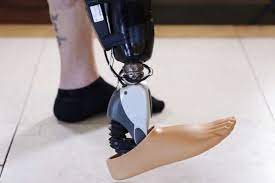
The new Ossur prosthetic foot changes how you walk. The prosthesis moves with you, flexing as a natural foot would. You have the freedom to look ahead more because you feel more stable. You will find yourself looking at people in their eyes again. You are less inclined to stoop over when you climb stairs. As you move uphill, your posture changes, relieving your back muscles. Wearing this prosthesis will help you to regain your former lifestyle. The Proprio Foot allows a greater toe clearance as you walk. The ankle adaptation will enable you to go up and down ramps without difficulty. Amputees no longer fear uneven surfaces because it flex as they walk. Proprio Foot because the world isn’t flat.
You No Longer Have the Fear of Stumbling
Amputees fall far more often than the able-bodied population. As a result, Amputees are much more afraid of losing their balance. Most rigid prostheses do not flex the way the Proprio Foot does. Stumbling occurs when the toe catches or you walk on an uneven surface like rocks. The Proprio Foot ends these problems. Wearing it, you quickly see how much more stable your gait has become. The Proprio Foot flexes as you walk and go down a slope. This improvement provides the exact toe clearance during the swing phase as your intact foot does. Stability on a prosthesis during the stance phase can also be compromised when using a non-adaptive prosthetic foot on variable terrain, both inclined and declined. Proprio Foot because the world isn’t flat.
Proprio Foot Because the World Isn’t Flat
Once you become afraid of falling, it is hard to overcome. Psychologists have found one of the best methods to encourage amputees to face their fear. When they feel more secure and are getting more feelings about their prosthesis in motion, that is why they invented it because the world isn’t flat. The amputee’s confidence and stability on stairs can be boosted when they can feel their ankle movement they are assured. Active swing phase dorsiflexion on Proprio Foot has been shown to increase ground clearance and reduce the likelihood of tripping, which could reduce the risk of falls. Proprio Foot stance phase and terrain adaptation technology are designed to improve stability on uneven terrains and improve mobility.
Proprio foot because the world isn’t flat
There are several studies that support this. One study reported that more than half of lower limb amputees fall once a year, placing them at high risk for adverse health outcomes like reduced mobility and diminished quality of life. Another large study found that one out of five amputees had fallen in a supervised setting like physical rehabilitation; eighteen percent of those who fell were seeking medical attention. Amputees with a history of falling show impaired mobility and significant fear. While falls in the amputee population are undoubtedly a concern, the implications of the fear of falling should not be overlooked. Once that fear has taken hold, it is very resistant to treatment.
Proprio Foot Means Feeling Stable Again
The first reaction to wearing this Foot is the relief of feeling stable again when walking. The risk of tripping is reduced with the increased ground clearance that the Proprio Foot provides. Stumbles, which cause falls, directly relate to ground clearance. Proprio Foot offers active dorsiflexion that provides 70% increased ground clearance during the swing phase, reducing the likelihood of tripping. As a result, users have reported fewer stumbles and falls with the Proprio Foot than with their previous prostheses. On average, over a 4-week trial, the number of reported stumbles decreased from 9.9 (previous prosthesis) to 5.3 (Proprio Foot), and the number of reported falls decreased from 3.4 to 1.0, a reduction of 70%.
Proprio Foot Provides Essential Benefits to Amputees
Prosthetic Stability is determined by the ability of the foot to adapt to the underlying terrain. Providing an ankle position that matches the underlying slope angle results in improved symmetry. Wearing a Proprio Foot reduces the amount of energy it takes to walk. The user walks more naturally, with more symmetry in loading and with an increased perception of safety in ramp descent. The terrain-compliant ankle compensates for increased peak loads from walking on uneven terrain. Descending stairs presents another challenge to the prosthetic user. With the Proprio Foot, the prosthetic ankle is pre-positioned into an individually selected ankle dorsiflexion allowing for deeper positioning into the step and more natural kinetics and kinematics on the prosthetic side.
In Conclusion, A Better Mousetrap?
That is why we say, “Proprio foot because the world isn’t flat.” It delivers value to both the user and the healthcare providers of the amputee population. It may decrease the amputee’s rate of falls through its powered four degrees of the swing phase in dorsiflexion, resulting in a reduced likelihood of tripping. It also may provide increased symmetry and socket comfort when walking on inclines by adapting to the terrain slope angle. Increasing symmetry and reducing the likelihood of tripping may improve the quality of life and reduce the economic burden of falls in the amputee population. Extend these advantages over a lifetime of steps, and the potential healthcare benefits become apparent.
Össur Proprio Foot: The Next Generation of Prosthetic Technology





